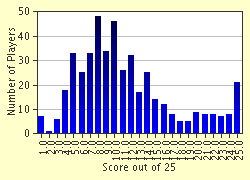Quiz Answer Key and Fun Facts
1. What city and state did this crime take place?
2. When was Mary Phagan murdered?
3. What was the name of the company that Mary worked at?
4. Who discovered Mary's body?
5. What evidence was found next to Mary's body?
6. How many days after the discovery of the body was Leo Frank arrested for the crime?
7. Who was the Solicitor-General of the case?
8. What was the name of the factory's janitor?
9. What was the name of the detective agency who was hired by Leo Frank to find the real killer?
10. Expert witness testified that drops of blood found on the lathe were Mary's.
11. Besides blood being found on the lathe, what else was found on it?
12. Who testified that she came to Leo Frank's office at 12:05 P.M. to collect her paycheck (thus contradicting Leo's statement that said at 12:05 P.M. Mary was there)?
13. Who was the star witness for the prosecution?
14. According to the prosecution, Leo Frank used a rope to kill Mary.
15. How many witnesses were called by the defense?
16. What was the name of the judge for the Leo Frank case?
17. Leo Frank was found not guilty of the murder?
18. At the time of this murder and trial, who was the Governor of the state of Georgia?
19. The Governor of Georgia fully exonerated Leo Frank.
20. During the time that the Governor was deciding whether to exonerate Leo, he read over the case. He recalled the state's star witness to retell his story. What did the Governor find instead?
21. What prison was Leo Frank sent to?
22. When did Leo Frank die?
23. The people who murdered Leo Frank were brought to justice?
24. Before becoming known as the Ku Klux Klan, what name were they known by at the time of this case?
25. What was the name of the person who helped to fully exonerate Leo Frank?
Source: Author
DakotaNorth
This quiz was reviewed by FunTrivia editor
gtho4 before going online.
Any errors found in FunTrivia content are routinely corrected through our feedback system.

